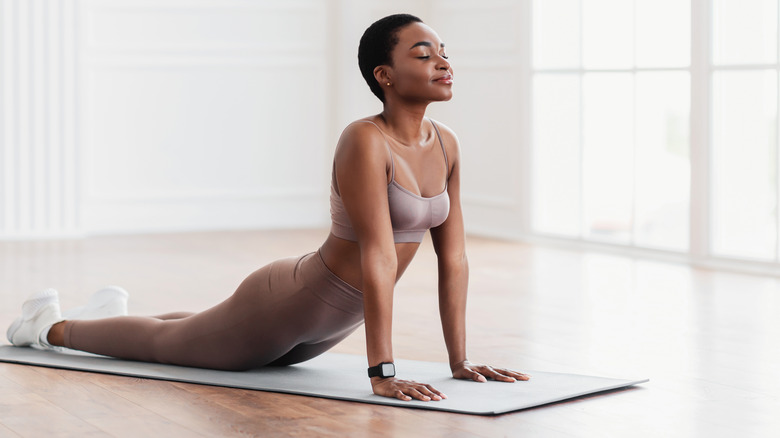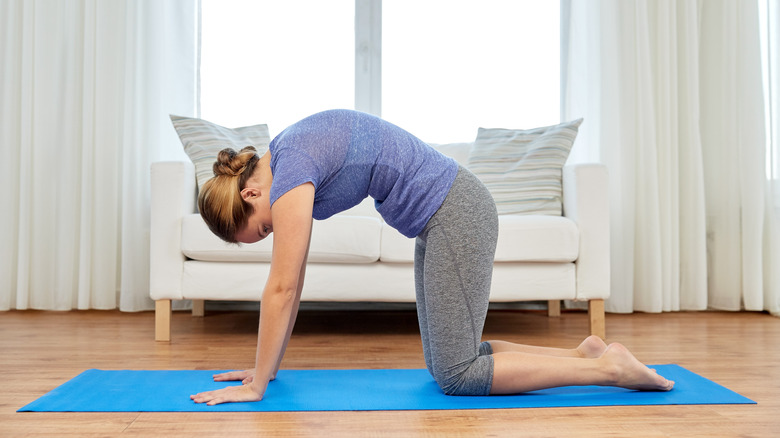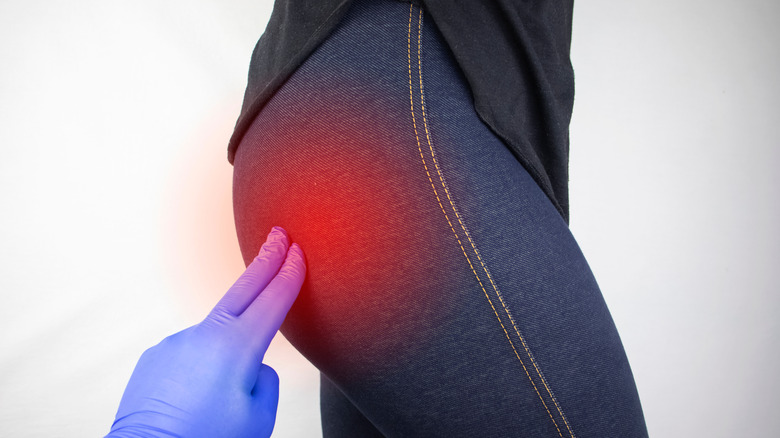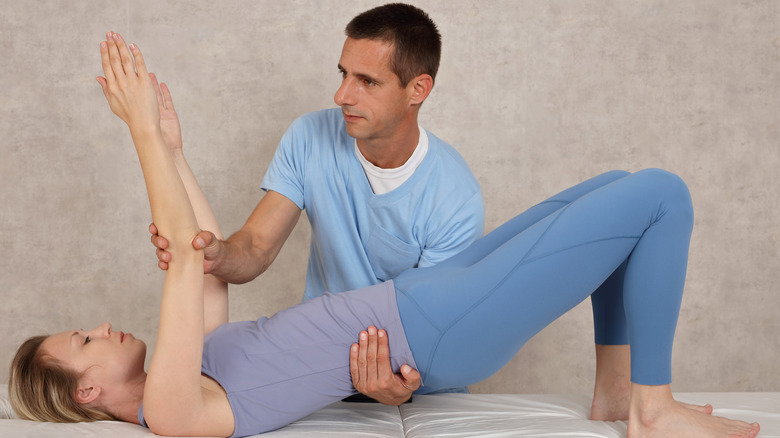The Best Stretches To Relieve Lower Back Pain
Lower back pain can interfere with your daily life, making it difficult to stay active. Things like walking, jogging, or even just standing can become a chore. It's often worse for people with spinal stenosis, sciatica, bulging discs, and other more severe types of low back pain. For example, sciatica can cause sharp pain and numbness, weakness, or tingling on one side of the body.
Chances are, you won't feel like working out when your symptoms flare up. But, believe it or not, regular exercise can ease back pain and improve your mobility, according to clinical research published in the Journal of Functional Morphology and Kinesiology. Whether we're talking about stretching, functional workouts, or strength training, physical activity is associated with reduced pain, increased lumbar flexion, and greater core strength. What's more, even short bouts of exercise appear to be effective. As the researchers found, stretching your joints and muscles for just 10 to 15 minutes a day, three to five days per week, may reduce lower back pain.
And other studies report similar findings. In a clinical trial, regular stretching decreased lower back pain and improved physical function in more than 80% of patients, according to the journal Pain Management Nursing.
However, some types of exercise are safer and more effective than others. For starters, try these stretches to relieve lower back pain and regain your mobility.
Try the cat-cow pose for back pain relief
The cat-cow pose, or Marjaryasana-Bitilasana, provides a gentle massage to your spine while reducing tension in the upper body. At the same time, it calms your mind and loosens tight muscles, preparing your body for exercise. Over time, it may reduce back and hip pain, improve digestion, and soothe menstrual cramps, says physical therapist Laura Meihofer.
To get started, kneel on the floor and place your arms under your shoulders. Maintain a neutral spine and take a few deep breaths to relax. Brace your core, arch your back, and bring your chest up while inhaling (the cow pose). Use your hips to control the movement.
Next, push the air out of your lungs and round your back toward the ceiling, pushing through your hands. Inhale and return to the cow pose. Repeat as many times as you feel comfortable. Hold each pose for a few seconds to get a better stretch. If your knees hurt, place a towel or blanket beneath them.
Stretch the piriformis to ease sciatica pain
Piriformis syndrome and low back pain go hand in hand, notes a 2004 review featured in the journal Orthopedic Clinics of North America. This condition may also cause pain and tenderness in the buttocks or legs because the piriformis muscle can put pressure on the sciatic nerve, explains Cedars-Sinai. The pain tends to worsen with walking, running, stair climbing, or after sitting for long periods.
Stretching the piriformis muscle can relieve the pain and discomfort, increasing your range of motion. For starters, lie on your back with your knees bent. Alternatively, you can place your right foot on top of an exercise ball. Bring your left ankle over your right thigh and then place your hands on the left knee. Pull that knee toward the opposite shoulder until you feel a stretch in your right thigh, recommends Rehab Science (via YouTube). Hold the contraction for a few seconds, switch legs, and repeat.
The National Academy of Sports Medicine also suggests stretching your hamstrings and hip flexors to loosen the piriformis muscle. Lateral tube walking, glute bridges, leg slides, and wall squats with an exercise ball can be helpful, too. These simple stretches are perfect for at-home workouts and may prevent or relieve sciatica pain in the long run.
Add pelvic tilt exercises to your workout
The pelvic tilt exercise has been recommended for back pain relief since the '80s, reports a 2016 study published in the Journal of Chiropractic Medicine. This movement activates the deep core muscles, taking some of the pressure off your lower back during day-to-day activities. At the same time, it stretches the lumbar spine and can relieve tight back muscles.
One way to do a pelvic tilt is to lie on your back with your knees bent at 60 degrees, according to Physiopedia. From this position, press your lower back and hips against the floor and push all the air out of your lungs. At the same time, tilt your pelvis backward while maintaining the natural curve of your spine. Take a deep breath, relax your lower back, and bring your pelvis forward.
As you progress, try to hold each stretch for a couple of seconds. Remember to take deep breaths and brace your core throughout the movement. Keep your buttocks on the floor and use your lower back to tilt the pelvis. Later, you may experiment with more advanced variations, such as the pelvic tilt with double knee tucks or single/double leg lowers, suggests Physiopedia.



